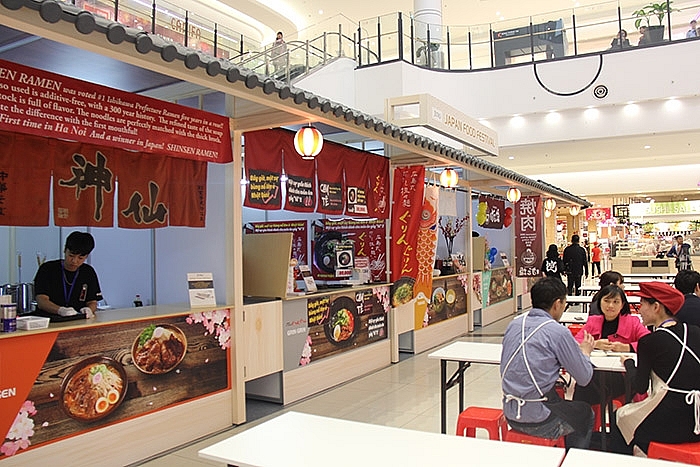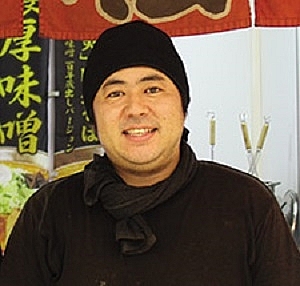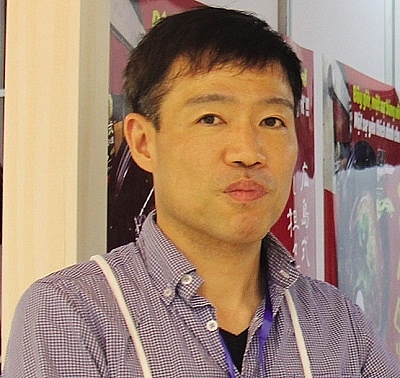Appetite for Japanese cuisine flares
 |
| Vietnamese customers show the growing demand for the world-famous Japanese cuisine |
Japanese restaurants began to appear in Vietnam in the mid-1990s and grew rapidly in the 2006-2007 period, but by 2012 the market grew somewhat saturated, intensifying competition. In recent years, however, the restaurant sector gained newfound wings.
Japanese food is becoming a favourite of Vietnamese people. Riding along Kim Ma street in Hanoi, along which the largest South Korean and Japanese enclaves are located, one can find an abundance of choice in Japanese restaurants. Japanese cuisine does not only have traction among Japanese expats, and chains like Tokyo Deli, Yakimono, Sushi Rei, and Gyu Shige can be found dotted all around the streets of Hanoi, Ho Chi Minh City, and other large cities and provinces.
The density of Japanese restaurants shows restaurateurs’ interest in the market, who are now one of the major gastronomic powerhouses besides Thai, South Korean, and local restaurants.
Last week, five companies from large cities of Japan participated in the Test Kitchen Vietnam 2019 food festival organised by the Japan External Trade Organization (JETRO) to introduce Japanese cuisine and look for investment opportunities in Vietnam.
Hironobu Kitagawa, chief representative of the JETRO Office in Hanoi, believed there is still great potential in opening Japanese restaurants in Vietnam as one of the main interests of Vietnamese tourists arriving to Japan is local cuisine. Besides, Japanese investment in Vietnam has been on the rise, and with it the number of Japanese visitors to Vietnam – as well as the accompanying services, including the restaurant sector, has also been increasing.
The potential also comes from the increased spending on food. According to Vietnam Report JSC, a Hanoi-based market research and business assessment firm, the country’s annual food consumption value is estimated to make up 15 per cent of its GDP. In the first nine months of 2018, the consumption index grew by 10.2 per cent against the same period last year for processed food and drinks.
Japanese restaurant chains already present in the market are non-stop expanding operations. For instance, Gyu Shige BBQ Restaurant – a brand with 130 successful restaurants in Japan – officially entered Vietnam in 2016 with its first store based in Ho Chi Minh City. After the first year, Gyu Shige’s sales in Vietnam grew by nearly 50 per cent month-on-month, with over 70 per cent of customers returning. Thus it issued the target to set up a chain of 30 branches within three years and up to 50-70 branches within five years.
Kentaro Takada, Global Development director of Gyu Shige, said, “Vietnam has been an economic hotspot in Southeast Asia for a few years, attracting many investors. Unlike the fierce competition of the food industry in Thailand, we see many opportunities to develop and decided to choose Vietnam as our first overseas market.”
Benefiting from stand-out
The potential of the market is quite clearly, however, newcomers will have to face competition from heavyweights from South Korea and Thailand, who have established solid footholds in the market already. It is easy to see that each national cuisine has their advantages.
Notably, Thai food matches Vietnamese people’s palate very well, while South Korean food has become trendy as a by-product of music such as K-Pop and the movie industry.
Japanese culture is famous for its elegance and sophistication, and unrivalled standards of quality of both the dishes and service – which obviously comes at a cost. Thus, Japanese restaurants target the mid- and high-income brackets. Meanwhile, the Vietnamese middle-class continues to grow, with a bigger focus on products with high quality, healthiness, and social status. This would means they are far more willing to open their wallets for high-end products.
“When Japanese companies open restaurants in Vietnam, they prefer to keep a direct hand in the management and expansion of the chain or in the selection of franchise partners, because they want to keep their brand’s soul unchanged, from knowhow to décor in every restaurant,” said Kitagawa from the JETRO Office.
However, in order to decrease the cost of ingredients, Japanese investors are beginning to look for local partners to ensure a supply satisfying Japanese standards, but at a far lower cost.
| Hidekazu Kitagawa Representative, Zenryokunomoto Company
Through the introduction of Vietnamese staff working at its restaurants in Japan, I decided to promote traditional Japanese noodles in Vietnam for the first time, to learn about customers’ taste and prepare a plan to open a restaurant in Vietnam. The Zenryokunomoto brand has done the same in Hawaii, Malaysia, Singapore, Taiwan, and Italy – receiving a warm welcome from consumers every time. However, opening a restaurant in these markets remains problematic due to difficulties in human resources. Meanwhile, Zenryokunomoto has Vietnamese staff working at our restaurants in Japan who understand the culture of the two countries, so opening a restaurant in Vietnam would not be so difficult. Currently, the brand is researching the two major markets of Hanoi and Ho Chi Minh City. On the other hand, there appear to be similar brands and products in Ho Chi Minh City already, so I am thinking about investing in Hanoi first. Traditional Japanese Miso noodles would be a novelty in Hanoi. In addition, Miso is handmade, which could become a signature for the company, offering a one-of-a-kind flavour in the market. Horii Manami Director, M’s Mission Co., Ltd.
I have prepared for this event [Test Kitchen Vietnam 2019 food festival] since November 2018. We are a famous restaurant for entrails in Japan, especially pig entrails, so we need high-quality ingredients. We came here to look for a good source in Vietnam. In addition, we want to taste the Vietnamese version of this dish to get a clearer understanding of the local taste. We know that Vietnamese people are hardworking, and we employ several Vietnamese workers at our stores in Japan, so I look forward to working with more lovely people in Vietnam by opening a store. Our brand has 50 years of history, dating back to my grandmother. With long experience, we hope to bring our special flavour to Vietnamese consumers. In Japan, we have two restaurants and in addition to the main dish of the entrails, we also have a very good chef who can make sushi and very tasty traditional Japanese dishes. Regarding the plans to open a restaurant in Vietnam, we will send our Vietnamese staff who are currently working at our restaurants in Japan to return and manage operations. Besides food, we want to bring Japanese service culture to Vietnam, and we trust that our staff who we directly trained in Japan will be able to play a key role in this. After this event, we will continue to study the Vietnamese market before deciding to invest and Hanoi seems like the ideal first choice. Yoshiyuki Kondo Shop manager, Adguild Japan Ltd.
I came to Vietnam to learn about the taste and food supply available to prepare for the food festival at AEON Mall. Vietnamese taste is different from Japan, for example, younger Japanese generations prefer saltier tastes. This event is an opportunity for our company to test how our products can stand up in Vietnam as well as study Vietnamese people’s taste. We are seeking for quality materials in Vietnam to prepare a plan in case we decide to break into the market. Based on differences in the Vietnamese and Japanese palate and eating habits, I will select sources of clean ingredients. Besides, some ingredients, such as sauce, soyu, and soy sauce originated from Japan may be purchased directly at AEON Vietnam, which will help reduce prices. The company also hopes to bring about a new outbreak with its dishes if we invest in Vietnam. |
What the stars mean:
★ Poor ★ ★ Promising ★★★ Good ★★★★ Very good ★★★★★ Exceptional
Related Contents
Latest News
More News
- Global partnerships key to Vietnam’s IFC development (December 26, 2025 | 16:18)
- Vingroup pulls out of bid to invest in North-South high-speed railway (December 26, 2025 | 11:42)
- Strengthening supply chains through trade promotions and customs reform (December 24, 2025 | 14:00)
- PM orders investment model for North–South high-speed rail (December 22, 2025 | 17:43)
- LS Eco Energy to invest in Vietnam rare earth sector (December 22, 2025 | 17:31)
- Government moves to establish International Financial Centre (December 21, 2025 | 21:00)
- Vietnam's IFC to target global investment flows (December 21, 2025 | 18:00)
- Two national hospitals expand capacity with new facilities (December 20, 2025 | 09:00)
- Ha Tinh breaks ground on major Vingroup industrial and energy projects (December 19, 2025 | 18:24)
- EVN launches major power infrastructure projects nationwide (December 19, 2025 | 18:17)




 Tag:
Tag:





















 Mobile Version
Mobile Version